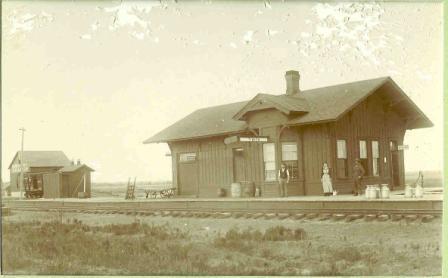The Rush County Historical Museum
It is quite possible that had it not been for a roller bearing, the Rush County Historical Museum would not exist as it does today. By the 1970s, the Historical Society, having had much success with the Post Rock Museum, was in a dilemma with a growing number of collections and not enough space to house them. When an abandoned depot in the town of Timken in southwestern Rush County was threatened with demolition, the Society had found the answer to their problem. But how does a museum housed in an abandoned depot owe its beginning to a roller bearing? The answer lies with a man by the name of Henry Timken, born in Germany nearly 150 years earlier.
Henry Timken and the Timken Roller Bearing
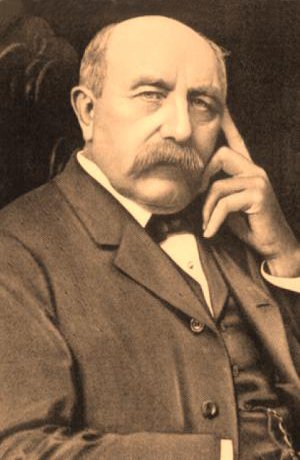 “Henry Timken was born August 16, 1831 on a farm near Bremen, Germany, one of seven children. His mother died when Henry was four and not too long afterwards,
in 1840, the family left for the American frontier. Henry Timken's first home in the United States was on a farm in Benton County, Missouri,
where he learned the lessons of hard work and self-denial. At the age of sixteen he became an apprentice in the manufacture of carriages in St. Louis.
For eight years, in two different carriage shops, he learned all there was to know about making carriages. By the time he was twenty-four,
he was ready to go into business for himself. For four years he operated his own carriage shop and for another five years he was in business
with his father-in-law in Belleville, Illinois. Two major historical events interrupted Henry Timken's drive to become the nation's leading
carriage builder: the Gold Rush and the Civil War.
“Henry Timken was born August 16, 1831 on a farm near Bremen, Germany, one of seven children. His mother died when Henry was four and not too long afterwards,
in 1840, the family left for the American frontier. Henry Timken's first home in the United States was on a farm in Benton County, Missouri,
where he learned the lessons of hard work and self-denial. At the age of sixteen he became an apprentice in the manufacture of carriages in St. Louis.
For eight years, in two different carriage shops, he learned all there was to know about making carriages. By the time he was twenty-four,
he was ready to go into business for himself. For four years he operated his own carriage shop and for another five years he was in business
with his father-in-law in Belleville, Illinois. Two major historical events interrupted Henry Timken's drive to become the nation's leading
carriage builder: the Gold Rush and the Civil War.
Just as they were to many young men of the day, the gold fields of California proved to be an overpowering temptation to Henry. And like the many who joined him there, he returned to St. Louis without a penny to his name. He then enlisted in the army and reached the rank of captain in the 13th Union Regiment. One more business reverse was yet to come before Henry Timken was to hit the high road to success. Upon his return from the army, he built a carriage plant only to have it destroyed by fire. However, Henry persevered and rebuilt the carriage plant. This time he was in business for keeps and his business grew. Henry Timken expanded his facilities and constantly improved his product. In 1877, he patented the Timken buggy spring, which became an absolute must in the finest carriages made in the 1880s. This was the first of the thirteen patents he secured in his lifetime. In 1895, he patented the tapered wheel bearings that revolutionized the infant motor car industry.” (From Rush County - 125 years in Story & Pictures)
The Railroad Arrives
During the latter part of the 1800s, railroads were responsible for the settlement of western Kansas. To spur development, the federal government gave land grants to the railroads along their right-of-ways. In 1859, Cyrus K. Holliday chartered the Atchison, Topeka & Santa Fe railroad and began building to the west across Kansas. Immediately after chartering his railroad, Holliday established real estate offices to sell parcels of these land grants. His idea was that these new farms would create a demand for both passenger and freight services. The AT&SF made their program appealing by offering discounted fares for prospective settlers to go west and inspect the land. If they purchased a parcel of land, the ticket price was applied toward the sale price of the land.
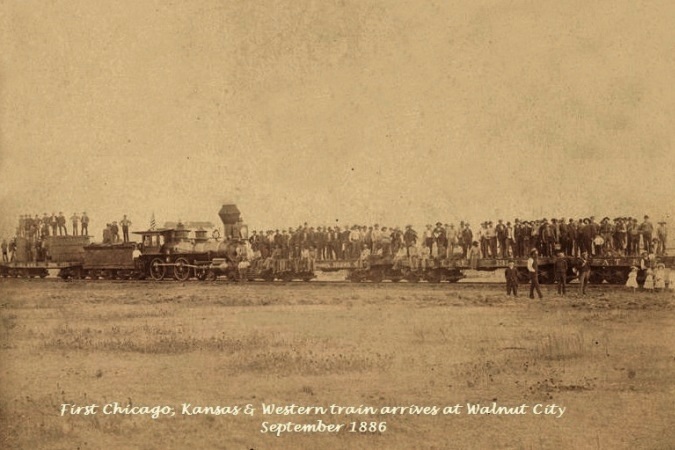 When the AT&SF reached Great Bend in 1886, their subsidiary, the Colorado, Kansas & Western (later known as the Scott City Branch of the
Atchison, Topeka & Santa Fe railroad began construction west from Great Bend through Rush County.
One of its subsidiaries, the Railroad Town Site Company, laid out town sites along the line of the proposed railroad. Henry Timken, in addition to his manufacturing interests,
was also a land speculator and had purchased some of these parcels of land in Rush County. Timken sold the section of land on which the
town of Timken is located to the Town Site Company and paid $2,000 for stock in the company on the condition that the town and rail station be
named Timken. Timken, Kansas is the only town or city in the country with that name.”
When the AT&SF reached Great Bend in 1886, their subsidiary, the Colorado, Kansas & Western (later known as the Scott City Branch of the
Atchison, Topeka & Santa Fe railroad began construction west from Great Bend through Rush County.
One of its subsidiaries, the Railroad Town Site Company, laid out town sites along the line of the proposed railroad. Henry Timken, in addition to his manufacturing interests,
was also a land speculator and had purchased some of these parcels of land in Rush County. Timken sold the section of land on which the
town of Timken is located to the Town Site Company and paid $2,000 for stock in the company on the condition that the town and rail station be
named Timken. Timken, Kansas is the only town or city in the country with that name.”
On September 6, 1886, the Timken Town Company, filed a plat of the area in Boston, Massachusetts with plans to sell parcels of the land. On July 11, 1887, the plat was filed in Rush County, by R.F. Ward, Register of Deeds. The Town Site Company surveyed and platted a large part of the section into city lots, but never sold a lot. Eventually, people settled the area and the town grew.
Building the Timken Depot
Beginning in the 1870s and throughout their history, the Atchison, Topeka, & Santa Fe relied upon a relatively standardized design for their depot buildings in smaller communities. The simple but attractive designs were inexpensive and easy to build. In 1910, the railroad adopted a series of eight standard design schemes, based upon those earlier structures, that shared a basic design. The combination passenger and freight stations were constructed with board-and-batten siding and a gable roof with long overhangs supported by decorative brackets. A bevel bay office window with a gable dormer added a simple yet elegant feature to the building. The buildings differed mainly in their size. There were four main line and four branch line designs ranging in size from 16'x40' for the “Number One” to 24'x80' for the “Number Four” design. Main line structures differed by having a larger office dormer to accommodate extra equipment needed in larger passenger markets. The standardized station plan soon became a trademark of the company.
The Timken station, dating back to 1887, was constructed prior to the adoption of the 1910 standardized scheme. However, the building resembles the “Number Two” plan. The 24'x42' combination building features a small waiting room adjacent to the telegraph operator's office and ticket counter, and an elevated freight room with loading platform in the rear. Notable features of the building include large six-over-six paned divided light windows in the office and waiting room and a moderately ornate office dormer with projecting gable tower. The building's windows and roof brackets differentiate it from later designs that feature six-over-nine paned windows and simple rafter tails instead of ornate brackets.
From the turn of the century, through the Great Depression, and into the years following World War II, the depot served the Timken area as its “link to the world.” However, the decade of the 1960s signaled a new direction for rural America's railroads. Change was on the horizon.
Saving the Timken Depot
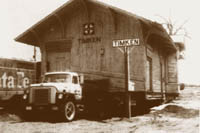 In the 1960s, the railroad discontinued passenger services, and regular freight service was cut back.
Depot agents were no longer assigned to small community depots. Railroad depots, once a hub of activity in the community, were left to sit silent. In the mid-1970s, the Santa Fe Railroad
abandoned most of its depots including the one in Timken. In an effort to preserve the historic structure from demolition, the Rush County Historical Society purchased the wooden building from the railroad for the
sum of $5.15 ($5.00 plus 15¢ tax). On May 27, 1975, the old depot building was loaded on the back of a truck and moved to Grass Park in La Crosse with plans to restore it as a museum.
In the 1960s, the railroad discontinued passenger services, and regular freight service was cut back.
Depot agents were no longer assigned to small community depots. Railroad depots, once a hub of activity in the community, were left to sit silent. In the mid-1970s, the Santa Fe Railroad
abandoned most of its depots including the one in Timken. In an effort to preserve the historic structure from demolition, the Rush County Historical Society purchased the wooden building from the railroad for the
sum of $5.15 ($5.00 plus 15¢ tax). On May 27, 1975, the old depot building was loaded on the back of a truck and moved to Grass Park in La Crosse with plans to restore it as a museum.
When the building arrived at its new home, it was situated on a full basement, a feature it originally did not have. Historical Society members then began the task of transforming the former train depot into an historical museum. Photographs, scrapbooks, dresses, uniforms, and other memorabilia were placed on display to tell the story of the people of Rush County. On April 17, 1983, the Rush County Historical Museum was dedicated as a museum of general history of the county. A new era in the life of the old depot had begun.
A New Coat of Old Colors
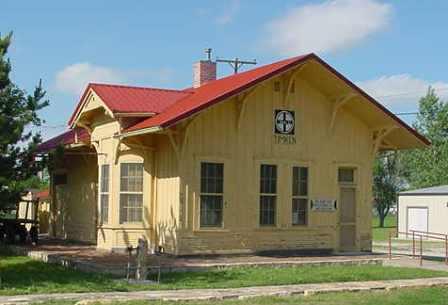 For years, most of the citizens of Rush County remember the Santa Fe depots for their trademark colonial yellow color. The
Timken depot was no different. When the building was showing a need to be repainted in 2002, a committee of historical society
members discussed options. Since the building had never been scraped down to the bare wood, subsequent repaintings had left the
building in such a state of decay that some members of the historical society suggested covering the historic building with metal siding.
For years, most of the citizens of Rush County remember the Santa Fe depots for their trademark colonial yellow color. The
Timken depot was no different. When the building was showing a need to be repainted in 2002, a committee of historical society
members discussed options. Since the building had never been scraped down to the bare wood, subsequent repaintings had left the
building in such a state of decay that some members of the historical society suggested covering the historic building with metal siding.
The implications of covering the historic structure stimulated a concerned citizen to donate the funds to remove all existing layers of paint and apply an oil-based primer and high-quality latex paint using a color scheme more representative of the era in which the depot was constructed. Dennis Elder, railroad buff and member of the historical society, obtained documentation of Santa Fe color schemes from the collections manager at Old Cowtown Museum in Wichita. The depot in Cowtown was painted mineral brown with dark green trim and white window mullions, the color typical of depots constructed prior to 1910. During the years 1930 through 1950, the Santa Fe painted its depots in the familiar yellow with bronze green trim. The Timken Depot, having been constructed prior to 1910, led society members to believe that it would have been painted in the mineral brown scheme. An early photo of the building showing it painted in a dark color further aluded to the possibility. When society members inspected the building, a close examination of exposed wood beneath layers of peeling yellow paint revealed that the building was indeed originally reddish-brown with green trim. There could be no doubt. Although the familiar yellow sidewalls and red roof was historically accurate, it was not representative of the depot's original design.
Research from Santa Fe Railroad archives allowed the society to produce a nearly exact match of the original reddish-brown and green paints. Donning protective gear to protect himself from the lead-based paint that covered the building, local painter Dean Jay worked evenings to remove the layers of old paint being careful not to damage the fragile wood siding. Once the wood was prepared, a coat of primer was applied followed by two finish coats. A red metal roof, which had only recently been installed was unfortunately not the right match. However, due to cost of replacement, society members were forced to compromise. Then, in July 2005, an afternoon hail storm caused substantial damage to the roof. In January 2006, the roof was replaced with a dark green metal. Today, the old building sports an attractive new coat of old colors not seen for nearly a century.
Sources:
Grant, H. Roger, Kansas Depots, 1990, Kansas State Historical Society, Topeka, KS
Reynolds, Judith, etal, Rush County - 125 Years in Story & Pictures, 2001, Rush County Historical Society, LaCrosse, KS
(author unknown), The Timken Company - A Brief History (publication and date unknown)
Henry Timken's Town, September 1, 1993, The Pelican Press, Larned, KS
